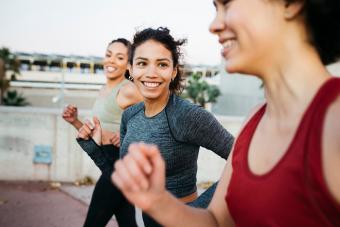
To accurately track your progress when starting a weight loss or weight management program, you may want to consider calculating and monitoring your body fat percentage. Unlike body weight or body mass index (BMI), which simply assess your size, body fat percentage analyzes what's going on inside your body, comparing your fat mass to your lean tissues. This helps provide a better picture of your total health while also correcting for "false positives" and "false negatives" that can occur when using weight or BMI.
Most Common Methods of Body Fat Assessment
Girth Measurements
While you can technically perform a girth assessment of yourself, your measurements will be more accurate if you ask someone to help you with the tape measure. Overall, girth measurements are accurate to within two and a half to four percent when performed correctly, and they're especially helpful for tracking changes in body fat distribution. Just remember, when taking measurements, the cloth or plastic tape measure should be held in a taut fashion around the point of measurement, but it should not be tight. You want to avoid compressing the skin.
While it's possible to calculate your body fat percentage by hand when using a girth measurement, there's no need to do that with the invention of the Internet. Using the tool provided on BrianMac, measure the girth of three body sites based on your age and gender. If your age is not cited on the graph, choose the segment you're closest to. After taking your measurements, plug your numbers into the tool (make sure you're taking your measurements in centimeters, not inches) and press "calculate." The result will be helpful in determining your general body fat range and will help you monitor progress over time.
Skinfold Testing
Skinfold testing is similar to girth measurements because you're measuring a number of sites on your body and using an equation to estimate total fat percentage based on these measurements. And, like girth measurements, the results are typically accurate to within three to five percent. Unfortunately, human error when testing can make these assessments extremely inaccurate, so it's important to have a trained individual perform the skinfold testing. Many personal trainers have been given nominal training on using skinfold calipers, so make sure you ask how the individual was trained and how many assessments he has performed before completely trusting the result. Individuals who have undergone training at a university or research center or who have performed numerous tests are more likely to use the calipers correctly. You can expect the following:
- The tester will use large calipers to "pinch" your skin on a number of sites. Most caliper tests involve either three or seven sites including everything from your triceps to your waist, thigh, back and calf. The three-site test locations vary between males and females, but the seven-site tests are the same.
- Testers should instruct you how to stand, locate the test site, then use their fingers to "pinch" the layer of subcutaneous fat away from the underlying muscle.
- Continuing to hold the skin with his fingers, the tester takes the first measurement with the calipers, releases the skin completely, then repeats the process again.
- The tester will continue the process at each of the sites of measurement, recording at least two measurements at each site.
- Before calculating body fat percentage, the tester will average each of the test site's scores to reduce inaccuracies caused by human error.
- The tester will use predetermined calculations or a computer system to assess your body fat percentage.
Like the girth measurements, skinfold testing is most helpful when tracking changes in body composition over time.
Bioelectrical Impedance Analysis (BIA)
BIA analysis is one of the most user-friendly systems for assessing body fat, but its accuracy is dependent on a number of factors, and at best is only accurate to within three percent. The way BIA works is fairly simple: fat-free mass like muscle, water and bone are all excellent electrical conductors, whereas fat conducts electricity more slowly. This means you can run a tiny electric current through a person, and based on how fast the current travels through the body, you can get an approximation of the person's body fat percentage. Some scales have this as a built-in feature, and there are hand-held versions, often in the price range of $100 or so. The nice thing is that you can test regularly from home, keeping an eye on changes as they occur. The downside is that the accuracy varies widely by things like hydration level, ambient temperature and even your menstrual cycle.
Hydrostatic Weighing
Hydrostatic weighing puts Archimedes' principle of water displacement into effect. The idea is fairly simple: denser bodies composed of more muscle and less fat will weigh more underwater than bodies with more fat and less fat-free mass. Simply put: fat floats, fat-free mass sinks. This is one of the most accurate tests available, and when performed correctly, determines body fat percentage to within one and a half percent. In order to have the test done, you typically have to set up a time at a hospital or university that has the proper equipment. If you're uncomfortable being submerged under water for at least 20 seconds, you may not want to undergo this test. Basically what happens is as follows:
-
When you arrive at the lab you'll be weighed and measured in various fashions while wearing only the clothing you'll be tested in (usually just a bathing suit).
-
You'll shower off completely, soaking the clothing you're wearing.
-
Testers will calibrate the equipment.
-
You'll enter the pool of water and sit as still as you can while the water settles and the system begins its measurements.
-
When instructed by the testers, you'll submerge yourself completely and exhale as much air as possible from your lungs. You'll remain submerged until you receive the predetermined "go ahead" signal from the testers to come up for air.
-
Typically you'll undergo this process two or three more times to help attain the most accurate reading.
Dual-Energy X-Ray Absorptiometry (DXA)
For a truly accurate reading of your body fat percentage, along with other measurements like your bone mineral density, check with your local hospital or university to see if they provide DXA body fat analysis. Testing can cost up to $200, depending on where you have it done, but the process is fairly simple and painless. You simply lie on your back on a table while two low-energy x-ray beams pass over your body over a 12-minute period. Computers reconstruct the x-ray beams to provide an accurate depiction of the underlying tissues, providing you an actual image of your bone, fat and fat-free mass.
Choosing a Method of Testing
The method you choose is really up to you, as long as you understand the benefits and drawbacks to each. Generally speaking, the easiest and least expensive methods tend to be less accurate, while the more difficult and more expensive methods tend to be more accurate. As a rule, it's best to get the most accurate measurements to assess your health and start or finish a new exercise program, using the less-accurate methods to simply track your progress. That said, If you choose a less-accurate method to begin with, stick with it as you track your progress, and try to keep all other variables the same. For instance, test on the same day, at the same time. If someone's helping you take measurements, always ask the same person to do it and make sure you use the same tools. The fewer variables you introduce into the equation, the better your results will be.







